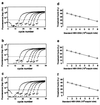Quantitation of hepatitis B virus genomic DNA by real-time detection PCR
- PMID: 10449472
- PMCID: PMC85408
- DOI: 10.1128/JCM.37.9.2899-2903.1999
Quantitation of hepatitis B virus genomic DNA by real-time detection PCR
Abstract
Quantitation of hepatitis B virus (HBV) DNA in serum is a useful method for the monitoring of HBV replication. We attempted to develop a quantitative assay system for HBV DNA that is more sensitive, accurate, and reproducible than existing systems. We detected HBV DNA by real-time detection PCR (RTD-PCR) based on Taq Man chemistry. The efficacy of this assay was evaluated by quantitatively measuring sequential levels of synthetic DNA and DNA in clinical serum samples. The detection limit of this system was as few as 10 DNA copies/reaction. A linear standard curve was obtained between 10(1) and 10(8) DNA copies/reaction. The coefficient of variation for both intra- and interexperimental variability indicated remarkable reproducibility. This system detected HBV DNA in 100% of chronic hepatitis B patients tested and never detected HBV DNA in healthy volunteers who were negative for HBV markers. These observations suggest that RTD-PCR is an excellent candidate for a standard HBV quantification method.
Figures



References
-
- Beasley R P. Hepatitis B virus—the major etiology of hepatocellular carcinoma. Cancer. 1988;61:1942–1956. - PubMed
-
- Dienstag J L, Perrillo R P, Schiff E R, Batholomew M, Vicary C, Rubin M. A preliminary trial of lamivudine for chronic hepatitis B infection. N Engl J Med. 1995;333:1657–1661. - PubMed
-
- Gerlich W H, Thomssen R. Terminology, structure and laboratory diagnosis of hepatitis viruses. In: McIntyre N, Benhamou J-P, Bircher J, Rizzetto M, Rodes J, editors. Oxford Textbook of clinical hepatology. Oxford, United Kingdom: Oxford University Press; 1991. pp. 537–565.
-
- Gibson U E M, Heid C A, Williams P M. A novel method for real time quantitation RT-PCR. Genome Res. 1996;6:995–1001. - PubMed
-
- Heid C A, Stevens J, Livak K J, Williams P M. Real time quantitative PCR. Genome Res. 1996;6:986–994. - PubMed
Publication types
MeSH terms
Substances
LinkOut - more resources
Full Text Sources
Other Literature Sources

